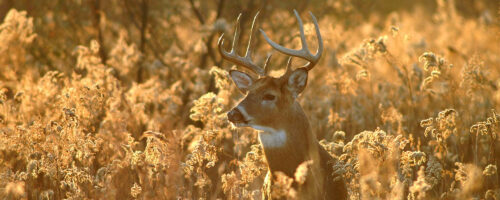Have you ever wondered why ruminant livestock such as cattle, sheep and goats, or wildlife such as deer, elk and bison eat what they do? For example, cattle and bison eat primarily grass; deer eat primarily forbs and browse (the edible leaves and stems of woody plants), but very little grass. Some ruminants, such as goats, have the ability to choose their diet across a wide spectrum of available plant types: grasses, forbs and woody vegetation.
A ruminant is an animal that has a four-compartment stomach and has the ability to re-chew ingested plants after they have been softened in the rumen. The rumen is the largest compartment of the ruminant’s stomach and sets this type of digestive system apart from that of monogastrics such as horses, pigs and humans.
Ruminant animals have been classified into three categories of feeding strategies based on digestive, behavioral and morphological differences. One classification is the grass-roughage feeder (GR). Cattle, elk and bison fall into this category. They have no upper teeth and use their tongue to sweep forage into their mouth and then pinch it between the upper dental pad and lower teeth, tearing it off. This type of grazing does not allow much selectivity. These herbivores ferment large amounts of fibrous, low quality forage in the rumen with help from microbes to break it down for digestion. When forage quantity is limited, too much time is spent searching for grass and more bites are required to harvest the grass needed to meet their daily requirement. When grass is in short supply, cattle will sometimes use more energy searching for forage than they get from it, thus losing body condition.
A different feeding strategy is used by the concentrate selector (CS). Deer and other CSs feed on easily digested, highly nutritious plants and plant parts. CSs have highly motile, prehensile lips and a narrow muzzle which allows selection and access to the most nutritious and digestible parts of a plant. Another attribute that allows CSs to graze selectively is their smaller body size. This small body size translates into a relatively lower absolute nutrient requirement for maintenance, which allows more time for seeking out higher quality forages. In addition, rate of passage in CSs is faster because they usually ingest higher quality, more digestible forage. When forage quantity is lacking, the CSs have an advantage over GRs.
The final category of feeding strategy is the intermediate feeder (IF). The IFs are those herbivores that exhibit versatility in their foraging behavior, which allows their diets to diverge from either the GR or CS. Diets of IFs can include plants and plant parts that GRs and CSs would not or could not utilize. For example, goats have a prehensile lip and can stand on their hind legs and reach browse inaccessible to other herbivores.
There is some debate about which category some ruminants, such as sheep and goats, fall into. Some say sheep are IFs and others say GRs. Sheep are versatile grazers that eat a high proportion of forbs and browse along with grass. Similarly, some think goats are IFs while others call them CSs. Goats, even more so than sheep, are highly versatile in their eating habits. Depending on the plant community and time of year, the amount of grass in a goat’s diet can range from 10-65 percent.
Take a look around your place and determine the foods available for the animals that you are trying to produce. If you are raising cattle, do them a favor and maintain adequate stubble height on your grasses so that they can be efficiently harvested. If you have mostly brush and forbs, then another kind of animal might be better suited for that environment.


Comment